Languages on self-provisioning pages
You can customize some or all of the text strings in the existing language files, so that they are consistent with your company style and vocabulary.
You can also customize text strings on the user portal and user login pages.
The self-provisioning pages appear during the SafeNet MobilePASS+, grIDsure, or FIDO self-provisioning workflows.
Protect your account page
The protect your account page is the first self-provisioning page that appears when a user tries to log in, but they don't have the required type of token.
The following images show the location of the key-value pairs on the protect your account page:
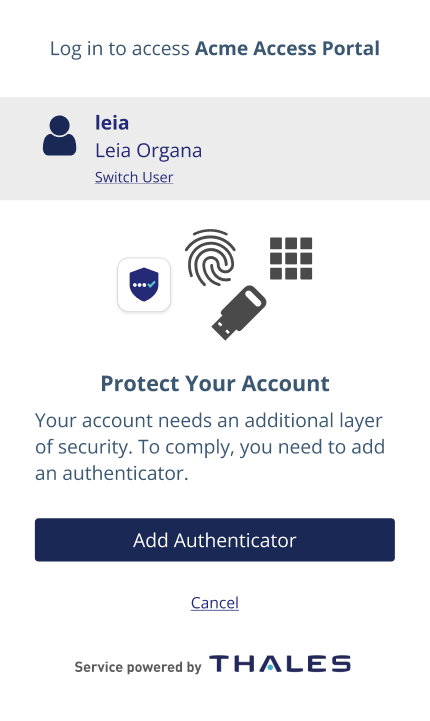
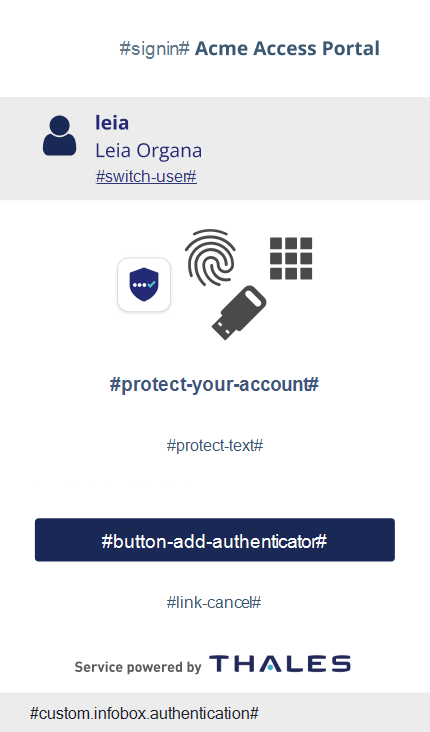
In the language files, you can customize the following values for the protect your account page:
| Key | Value |
|---|---|
| signin | Log in to access |
| switch-user | Switch User |
| protect-your-account | Protect Your Account |
| protect-text | Your account needs an additional layer of security. To comply, you need to add an authenticator. |
| button-add-authenticator | Add Authenticator |
| link-cancel | Cancel |
| custom.infobox.authentication | See Custom languages on the user portal and login pages |
Add authenticator page
The add authenticator page appears after the protect your account page.
The following images show the location of the key-value pairs on the add authenticator page:
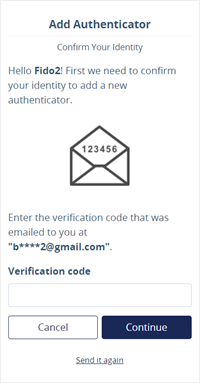
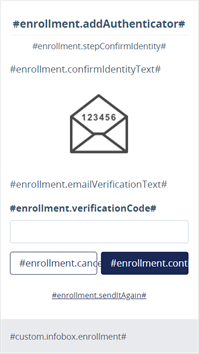
In the language files, you can customize the following values for the add authenticator page:
| Key | Value |
|---|---|
| enrollment.addAuthenticator | Add Authenticator |
| enrollment.stepConfirmIdentity | Confirm Your Identity |
| enrollment.confirmIdentityText | Hello <strong>{{ username }}</strong>! First we need to confirm your identity to add a new authenticator. |
| enrollment.emailVerificationText | Enter the verification code that was emailed to you at <strong>{{ maskedEmail }}</strong>. |
| enrollment.verificationCode | Verification code |
| enrollment.cancel | Cancel |
| enrollment.continue | Continue |
| enrollment.sendItAgain | Send it again |
| custom.infobox.enrollment | See Custom languages on the user portal and login pages |
Domain password page
The domain password page appears when users have a synchronized Active Directory password, which is used instead of email verification.
The following images show the location of the key-value pairs on the domain password page:
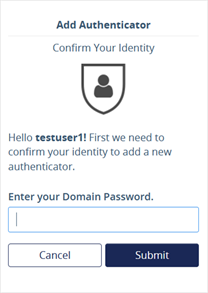
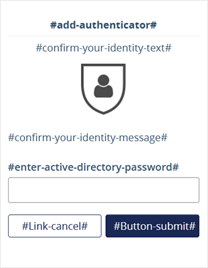
In the language files, you can customize the following values for the add authenticator page:
| Key | Value |
|---|---|
| add-authenticator | Add Authenticator |
| confirm-your-identity-text | Confirm Your Identity |
| confirm-your-identity-message | Hello <b>$1!</b> First we need to confirm your identity to add a new authenticator. |
| enter-active-directory-password | Enter your Domain Password. |
| reset-password | Reset password Displayed only if SafeNet Agent for Password Management is configured. |
| Link_cancel | Cancel |
| button-submit | Submit |
Select authenticator page
The select authenticator page appears after the add authenticator page.
The following images show the location of the key-value pairs on the select authenticator page:
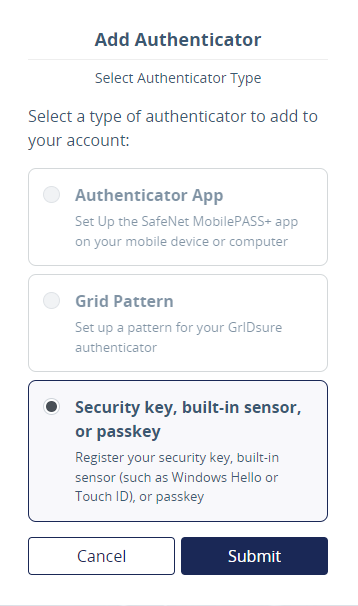
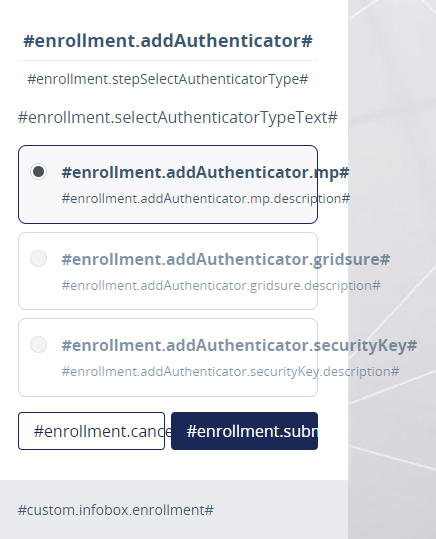
In the language files, you can customize the following values for the add authenticator page:
| Key | Value |
|---|---|
| enrollment.addAuthenticator | Add Authenticator |
| enrollment.stepSelectAuthenticatorType | Select Authenticator Type |
| enrollment.selectAuthenticatorTypeText | Select a type of authenticator to add to your account: |
| enrollment.addAuthenticator.mp | Authenticator App |
| enrollment.addAuthenticator.mp.description | Set Up the SafeNet MobilePASS+ app on your mobile device or computer |
| enrollment.addAuthenticator.gridsure | Grid Pattern |
| enrollment.addAuthenticator.gridsure.description | Set up a pattern for your GrIDsure authenticator |
| enrollment.addAuthenticator.securityKey | Security key, built-in sensor, or passkey |
| enrollment.addAuthenticator.securityKey.description | Register your security key, built-in sensor (such as Windows Hello or Touch ID), or passkey |
| enrollment.cancel | Cancel |
| enrollment.submit | Submit |
| custom.infobox.enrollment | See Custom languages on the user portal and login pages |
GriDsure self-provisioning pages
How GrIDsure works page
The how GrIDsure works page appears after grid pattern is selected on the add authenticator page.
The following images show the location of the key-value pairs on the how GrIDsure works page:

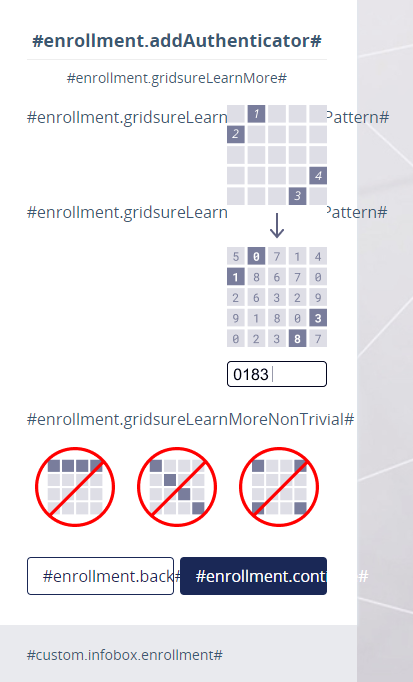
In the language files, you can customize the following values for the how GrIDsure works page:
| Key | Value |
|---|---|
| enrollment.AddAuthenticator | Add Authenticator |
| enrollment.gridsureLearnMore | How GrIDsure works |
| enrollment.gridsureLearnMoreChoosePattern | Choose a unique pattern that you’ll remember. |
| enrollment.gridsureLearnMoreUniquePattern | You will type a different passcode each time based on your chosen pattern. |
| enrollment.gridsureLearnMoreNonTrivial | It is safer to choose a pattern that is hard to guess. |
| enrollment.back | Back |
| enrollment.continue | Continue |
| custom.infobox.enrollment | See Custom languages on the user portal and login pages |
Set up GrIDsure page
The following images show the location of the key-value pairs on the Set up GrIDsure page:
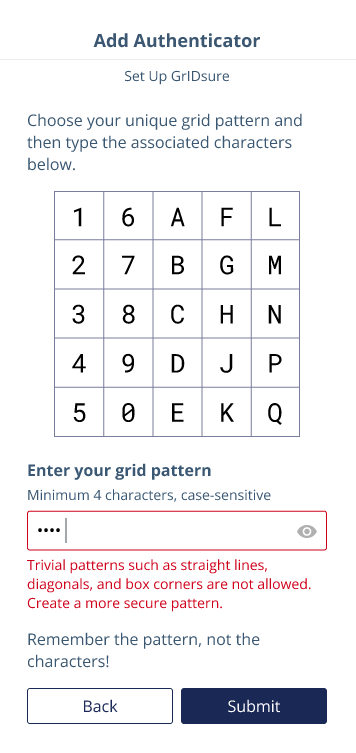
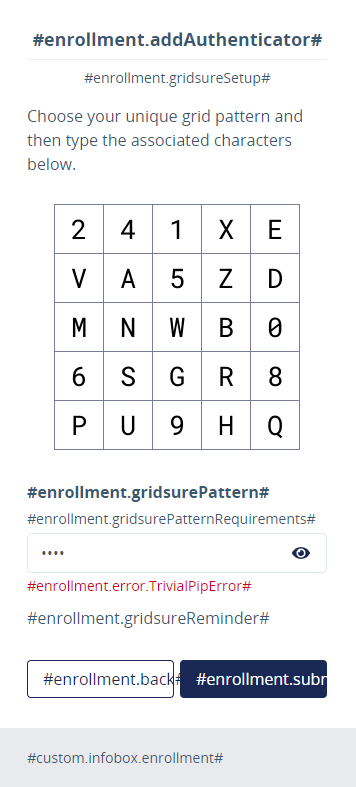
In the language files, you can customize the following values for the Set up GrIDsure page:
| Key | Value |
|---|---|
| enrollment.addAuthenticator | Add Authenticator |
| enrollment.gridsureSetup | Set Up GrIDsure |
| enrollment.gridsureInstructions | Choose your unique grid pattern and then type the associated characters below. |
| enrollment.gridsureEnterPattern | Enter your grid pattern |
| enrollment.gridsurePatternRequirements | Minimum {{ minLength }} characters, case-sensitive |
| enrollment.error.TrivialPipError | Trivial patterns such as straight lines, diagonals, and box corners are not allowed. Create a more secure pattern. |
| enrollment.error.MinLengthPipError | Pattern is too short. Minimum {{ minLength }} characters. |
| enrollment.error.DuplicatePipLocationError | Same grid location was used more than twice. |
| enrollment.error.InvalidPipCharacterError | Invalid characters were used. |
| enrollment.error.EmptyPipError | Required |
| enrollment.gridsureReminder | Remember the pattern, not the characters! |
| enrollment.back | Back |
| enrollment.submit | Submit |
| custom.infobox.authentication | See Custom languages on the user portal and login pages |
Set up GrIDsure PIN page
The set up GrIDsure PIN page appears when the Server-side User Select option is enabled; prompting users to add a PIN to their grid pattern.
The following images show the location of the key-value pairs on the set up GrIDsure PIN page:
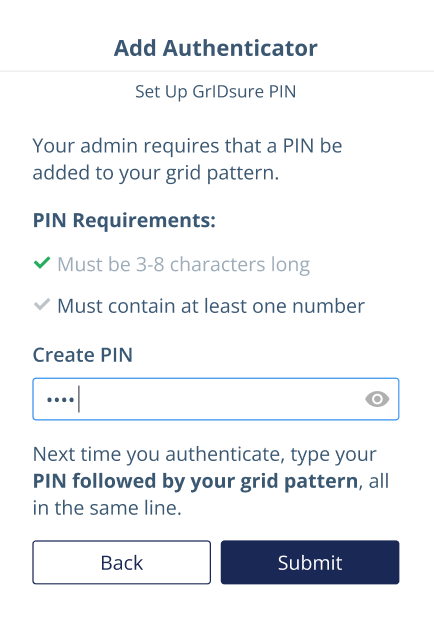
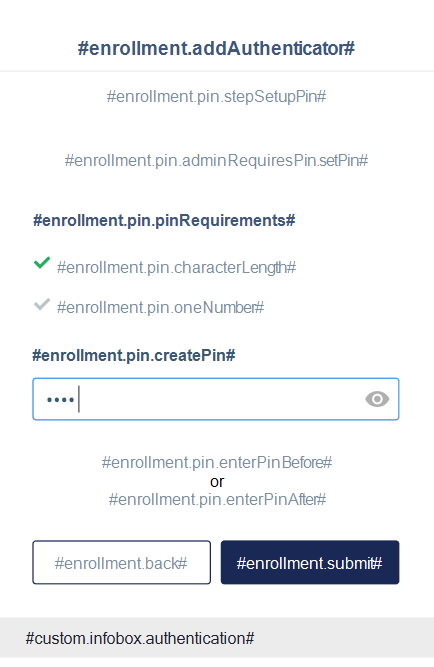
In the language files, you can customize the following values for the set up GrIDsure PIN page:
| Key | Value |
|---|---|
| enrollment.addAuthenticator | Add Authenticator |
| enrollment.pin.stepSetupPin | Set Up GrIDsure PIN |
| enrollment.pin.adminRequiresPin.setPin | Your admin requires that a PIN be added to your grid pattern. |
| enrollment.pin.pinRequirements | PIN Requirements: |
| enrollment.pin.characterLength | Must be |
| enrollment.pin.oneUppercase | Must contain at least one uppercase letter |
| enrollment.pin.oneLowercase | Must contain at least one lowercase letter |
| enrollment.pin.oneNumber | Must contain at least one number |
| enrollment.pin.specialCharacter | Must contain at least one special character like ! @ # $ % & * ? |
| enrollment.pin.createPin | Create PIN |
| enrollment.pin.enterPinBefore | Next time you authenticate, type your PIN followed by your grid pattern, all in the same line. |
| enrollment.pin.enterPinAfter | Next time you authenticate, type your grid pattern followed by your PIN, all in the same line. |
| enrollment.back | Back |
| enrollment.submit | Submit |
| custom.infobox.enrollment | See Custom languages on the user portal and login pages |
Your GrIDsure PIN page
The Your GrIDsure PIN page appears when the Server-side Server Select or Server-side Fixed option is enabled; prompting users to remember their assigned PIN.
The following images show the location of the key-value pairs on the Your GrIDsure PIN page:
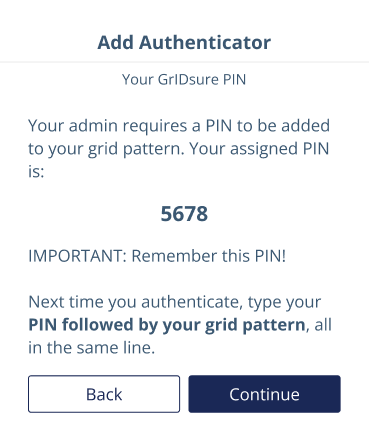
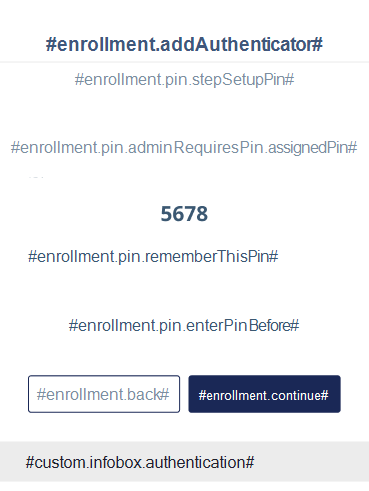
In the language files, you can customize the following values for the set up GrIDsure PIN page:
| Key | Value |
|---|---|
| enrollment.addAuthenticator | Add Authenticator |
| enrollment.pin.stepYourPin | Your GrIDsure PIN |
| enrollment.pin.adminRequiresPin.assignedPin | Your admin requires a PIN to be added to your grid pattern. Your assigned PIN is: |
| enrollment.pin.rememberThisPin | IMPORTANT: Remember this PIN! |
| enrollment.pin.enterPinBefore | Next time you authenticate, type your PIN followed by your grid pattern, all in the same line. |
| enrollment.back | Back |
| enrollment.continue | Continue |
| custom.infobox.enrollment | See Custom languages on the user portal and login pages |
Got your PIN memorized? page
The Got your PIN memorized? page appears after the assigned PIN is displayed on the Your GrIDsure PIN page and Continue is selected.
The following images show the location of the key-value pairs on the Got your PIN memorized? page:
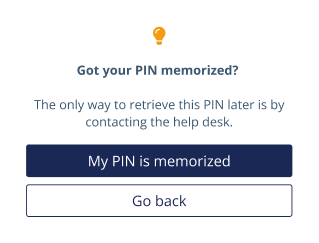
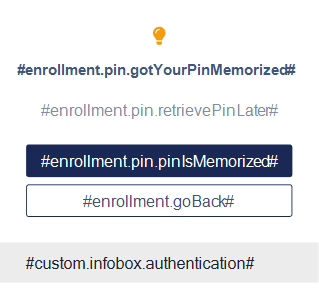
In the language files, you can customize the following values for the Got your PIN memorized? page:
| Key | Value |
|---|---|
| enrollment.pin.gotYourPinMemorized | Got your PIN memorized? |
| enrollment.pin.retrievePinLater | The only way to retrieve this PIN later is by contacting the help desk. |
| enrollment.pin.pinIsMemorized | My PIN is memorized |
| enrollment.goBack | Go back |
| custom.infobox.enrollment | See Custom languages on the user portal and login pages |
GrIDsure login page
The GrIDsure login page appears when the authentication method is OTP and the user has a GrIDsure token.
The following images show the location of the key-value pairs on the GrIDsure page:

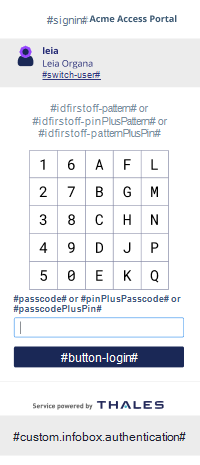
In the language files, you can customize the following values for the GrIDsure page:
| Key | Value |
|---|---|
| signin | Log in to access |
| switch-user | Switch User |
| idfirstoff-pattern | Please enter characters in sequence corresponding to your chosen pattern. |
| idfirstoff-pinPlusPattern | Type your PIN followed by the characters that correspond to your chosen pattern. |
| idfirstoff-patternPlusPin | Type the characters that correspond to your chosen pattern followed by your PIN. |
| pinPlusPatternHelpText | Type your PIN and pattern in order, all in one line with no spaces. For example, if your PIN is 1234 and your pattern characters are 5678, type 12345678. |
| patternPlusPinHelpText | Type your pattern and PIN in order, all in one line with no spaces. For example, if your pattern characters are 1234 and your PIN is 5678, type 12345678. |
| passcode | Passcode |
| pinPlusPasscode | PIN + Passcode |
| passcodePlusPin | Passcode + PIN |
| button-login | Login |
| custom.infobox.authentication | See Custom languages on the user portal and login pages |
SafeNet MobilePASS+ self-provisioning
Select device page
The select device page appears after the add authenticator page.
The following images show the location of the key-value pairs on the select device page:
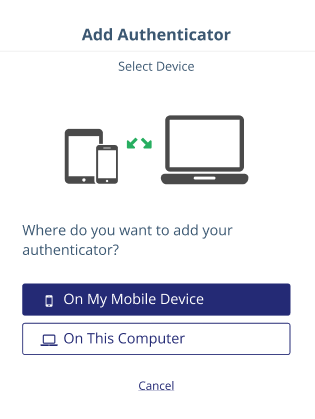
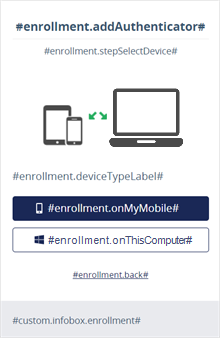
In the language files, you can customize the following values for the select device page:
| Key | Value |
|---|---|
| enrollment.addAuthenticator | Add Authenticator |
| enrollment.stepSelectDevice | Select Device |
| enrollment.deviceTypeLabel | Where do you want to add your authenticator? |
| enrollment.onMyMobile | On My Mobile Device |
| enrollment.onThisComputer | On This Computer |
| enrollment.back | Back |
| custom.infobox.enrollment | See Custom languages on the user portal and login pages |
Activate SafeNet MobilePASS+ on your computer page
The SafeNet MobilePASS+ on your computer page appears after you select enrollment.onThisComputer on the add device page and a link to the installer is not displayed.
The following images show the location of the key-value pairs on the activate SafeNet MobilePASS+ on your computer page:
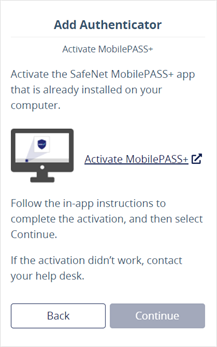
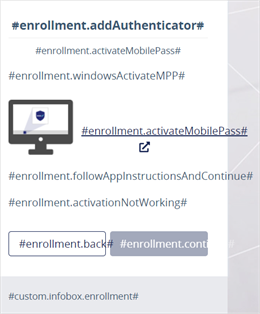
In the language files, you can customize the following values for the activate SafeNet MobilePASS+ on your computer page:
| Key | Value |
|---|---|
| enrollment.addAuthenticator | Add Authenticator |
| enrollment.activateMobilePass | Activate\nMobilePASS+ |
| enrollment.computerActivateMPP | Activate the SafeNet MobilePASS+ app that is already installed on your computer. |
| enrollment.followAppInstructionsAndContinue | Follow the in-app instructions to complete the activation, and then select Continue. |
| enrollment.activationNotWorking | If the activation didn’t work, contact your help desk. |
| enrollment.back | Back |
| enrollment.continue | Continue |
| custom.infobox.enrollment | See Custom languages on the user portal and login pages |
Install and activate SafeNet MobilePASS+ on your computer page
The install and activate SafeNet MobilePASS+ on your computer page appears after you select enrollment.onThisComputer on the add device page and a link to the installer is displayed.
The following images show the location of the key-value pairs on the install and activate SafeNet MobilePASS+ on your computer page:
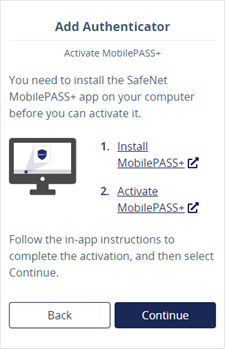
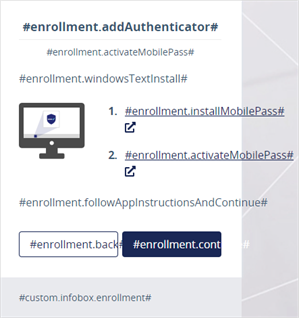
In the language files, you can customize the following values for the install and activate SafeNet MobilePASS+ on your computer page:
| Key | Value |
|---|---|
| enrollment.addAuthenticator | Add Authenticator |
| enrollment.activateMobilePass | Activate\nMobilePASS+ |
| enrollment.computerTextInstall | You need to install the SafeNet MobilePASS+ app on your computer before you can activate it. |
| enrollment.installMobilePass | Install\nMobilePASS+ |
| enrollment.followAppInstructionsAndContinue | Follow the in-app instructions to complete the activation, and then select Continue. |
| enrollment.back | Back |
| enrollment.continue | Continue |
| custom.infobox.enrollment | See Custom languages on the user portal and login pages |
Select mobile OS page
The select mobile OS page appears after you select enrollment.onMyMobile on the select device screen.
The following images show the location of the key-value pairs on the select mobile OS page:
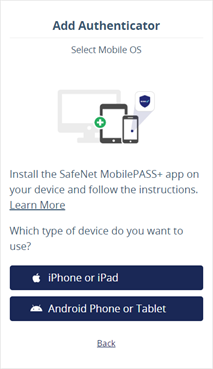
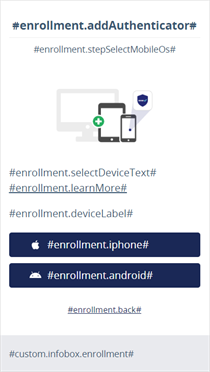
In the language files, you can customize the following values for the select mobile OS page:
| Key | Value |
|---|---|
| enrollment.addAuthenticator | Add Authenticator |
| enrollment.stepSelectMobileOs | Select Mobile OS |
| enrollment.selectDeviceText | Install the SafeNet MobilePASS+ app on your device and follow the instructions |
| enrollment.learnMore | Learn More |
| enrollment.deviceLabel | Which type of device do you want to use? |
| enrollment.iphone | iPhone or iPad |
| enrollment.android | Android Phone or Tablet |
| enrollment.back | Back |
| custom.infobox.enrollment | See Custom languages on the user portal and login pages |
About SafeNet MobilePASS+ page
The about SafeNet MobilePASS+ page appears when you click enrollment.learnMore on the select mobile OS page.
The following images show the location of the key-value pairs on the SafeNet MobilePASS+ page:
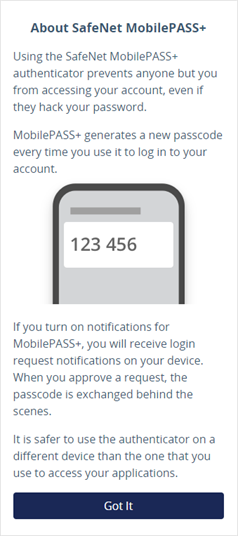
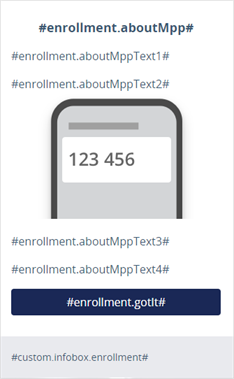
In the language files, you can customize the following values for the SafeNet MobilePASS+ page:
| Key | Value |
|---|---|
| enrollment.aboutMpp | About SafeNet MobilePASS+ |
| enrollment.aboutMppText1 | Using the SafeNet MobilePASS+ authenticator prevents anyone but you from accessing your account, even if they hack your password. |
| enrollment.aboutMppText2 | MobilePASS+ generates a new passcode every time you use it to log in to your account. |
| enrollment.aboutMppText3 | If you turn on notifications for MobilePASS+, you will receive login request notifications on your device. When you approve a request, the passcode is exchanged behind the scenes. |
| enrollment.aboutMppText4 | It is safer to use the authenticator on a different device than the one that you use to access your applications. |
| enrollment.gotIt | Got It |
| custom.infobox.enrollment | See Custom languages on the user portal and login pages |
SafeNet MobilePASS+ on iOS page
The SafeNet MobilePASS+ on iOS page appears after you select enrollment.iphone on the select mobile OS screen.
The following images show the location of the key-value pairs on the SafeNet MobilePASS+ on iOS page:
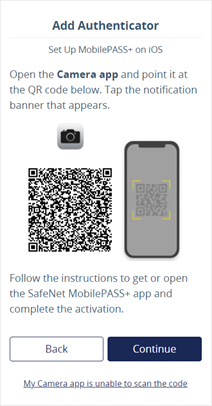
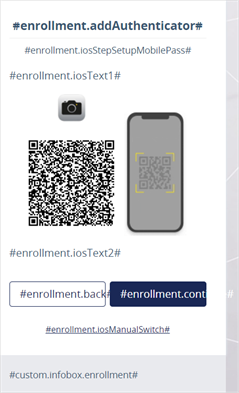
In the language files, you can customize the following values for the SafeNet MobilePASS+ on iOS page:
| Key | Value |
|---|---|
| enrollment.addAuthenticator | Add Authenticator |
| enrollment.iosStepSetupMobilePass | Set Up MobilePASS+ on iOS |
| enrollment.cameraText | Open the Camera app and point it at the QR code below. Tap the notification banner that appears. |
| enrollment.QRCodeAltText | QR Code. This is alternative (alt) text for the QR code. |
| enrollment.getMobilePassAndContinue | Follow the instructions to get or open the SafeNet MobilePASS+ app and complete the activation. |
| enrollment.back | Back |
| enrollment.continue | Continue |
| enrollment.mobileManualSwitch | My Camera app is unable to scan the code |
| custom.infobox.enrollment | See Custom languages on the user portal and login pages |
Manual SafeNet MobilePASS+ iOS page
The manual SafeNet MobilePASS+ on iOS page appears after you select the enrollment.mobileManualSwitch link on the set up SafeNet MobilePASS+ on iOS screen.
The following images show the location of the key-value pairs on the SafeNet MobilePASS+ on iOS page:
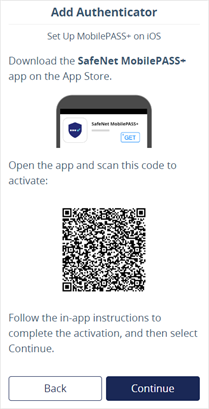
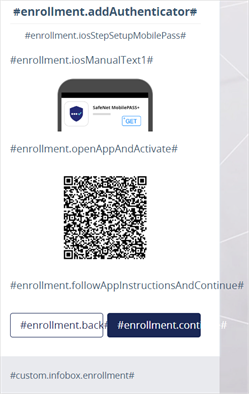
In the language files, you can customize the following values for the manual SafeNet MobilePASS+ on iOS page:
| Key | Value |
|---|---|
| enrollment.addAuthenticator | Add Authenticator |
| enrollment.iosStepSetupMobilePass | Set Up MobilePASS+ on iOS |
| enrollment.iosManualText1 | Download the <strong>SafeNet MobilePASS+</strong> app on the App Store. |
| enrollment.openAppAndActivate | Open the app and scan this code to activate: |
| enrollment.followAppInstructionsAndContinue | Follow the in-app instructions to complete the activation, and then select Continue. |
| enrollment.back | Back |
| enrollment.continue | Continue |
| custom.infobox.enrollment | See Custom languages on the user portal and login pages |
Initiated from iOS page
The initiated from iOS page appears when enrollment is initiated from an iOS device.
The following images show the location of the key-value pairs on the initiated from iOS page:
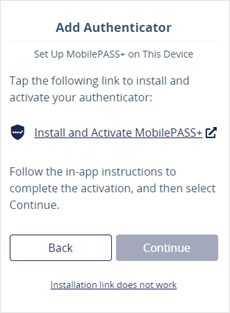
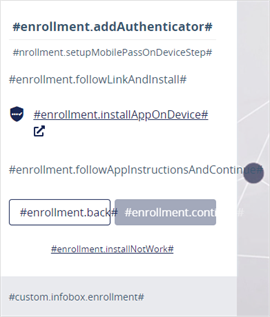
In the language files, you can customize the following values for the initiated from iOS page:
| Key | |
|---|---|
| enrollment.addAuthenticator | Add Authenticator |
| enrollment.setupMobilePassOnDeviceStep | Set Up MobilePASS+ on This Device |
| enrollment.followLinkAndInstall | Tap the following link to install and activate your authenticator: |
| enrollment.installAppOnDevice | Install and Activate MobilePASS+ |
| enrollment.followAppInstructionsAndContinue | Follow the in-app instructions to complete the activation, and then select Continue. |
| enrollment.back | Back |
| enrollment.continue | Continue |
| enrollment.installNotWork | Installation link does not work |
| custom.infobox.enrollment | See Custom languages on the user portal and login pages |
Download SafeNet MobilePASS+ for iOS page
The download SafeNet MobilePASS+ for iOS page appears when you click enrollment.installNotWork on the initiated from iOS page.
The following images show the location of the key-value pairs on download SafeNet MobilePASS+ for iOS page:
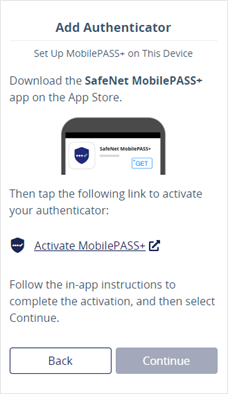
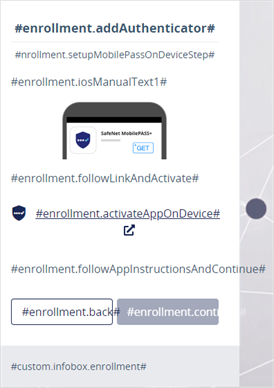
In the language files, you can customize the following values for the download SafeNet MobilePASS+ for iOS page:
| Key | Value |
|---|---|
| enrollment.addAuthenticator | Add Authenticator |
| enrollment.setupMobilePassOnDeviceStep | Set Up MobilePASS+ on This Device |
| enrollment.iosManualText1 | Download the <strong>SafeNet MobilePASS+</strong> app on the App Store. |
| enrollment.followLinkAndActivate | Then tap the following link to activate your authenticator: |
| enrollment.activateAppOnDevice | Activate MobilePASS+ |
| enrollment.followAppInstructionsAndContinue | Follow the in-app instructions to complete the activation, and then select Continue. |
| enrollment.back | Back |
| enrollment.continue | Continue |
| custom.infobox.enrollment | See Custom languages on the user portal and login pages |
SafeNet MobilePASS+ on Android page
The set up SafeNet MobilePASS+ on Android page appears after you select enrollment.android on the select mobile OS page.
The following images show the location of the key-value pairs on the SafeNet MobilePASS+ on Android page:
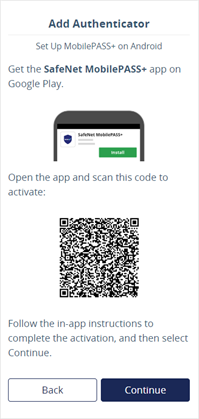
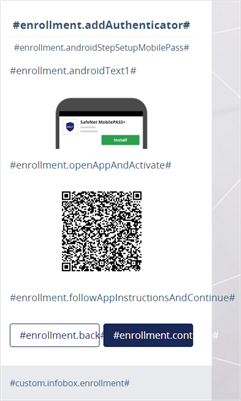
In the language files, you can customize the following values for SafeNet MobilePASS+ on Android page:
| Key | Value |
|---|---|
| enrollment.addAuthenticator | Add Authenticator |
| enrollment.androidStepSetupMobilePass | Set Up MobilePASS+ on Android |
| enrollment.androidText1 | Get the <strong>SafeNet MobilePASS+</strong> app on Google Play. |
| enrollment.openAppAndActivate | Open the app and scan this code to activate: |
| enrollment.followAppInstructionsAndContinue | Follow the in-app instructions to complete the activation, and then select Continue. |
| enrollment.back | Back |
| enrollment.continue | Continue |
| custom.infobox.enrollment | See Custom languages on the user portal and login pages |
Enrollment success page
The enrollment success page appears after you successfully activate and enroll SafeNet MobilePASS+.
The following images show the location of the key-value pairs on the enrollment success page:
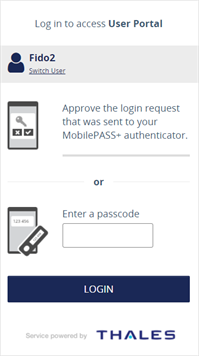
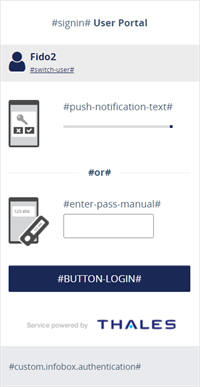
In the language files, you can customize the following values for the enrollment success page:
| Key | Value |
|---|---|
| signin | Log in to access |
| switch-user | Switch User |
| push-notification-text | Approve the login request that was sent to your MobilePASS+ authenticator. |
| enter-pass-manual | Enter a passcode |
| button-login | Login |
| custom.infobox.authentication | See Custom languages on the user portal and login pages |
Enrollment not activated page
The enrollment not activated page appears when you select Continue on the activate SafeNet MobilePASS+ page, but have not yet activated and enrolled SafeNet MobilePASS+.
The following images show the location of the key-value pairs on the enrollment not activated page:
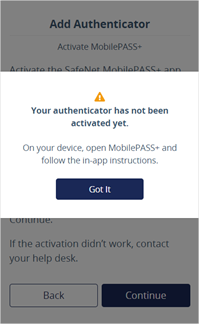
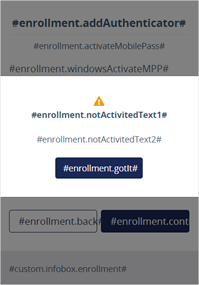
In the language files, you can customize the following values for the enrollment not activated error page:
| Key | Value |
|---|---|
enrollment.checkingStatus |
Let’s check if your authenticator has been activated… This message appears briefly before the enrollment not activated messages are displayed. |
enrollment.notActivitedText1 |
Your authenticator has not been activated yet. |
enrollment.notActivitedText2 |
On your device, open MobilePASS+ and follow the in-app instructions. |
enrollment.gotIt |
Got It |
FIDO self-provisioning
FIDO enrollment page
The FIDO enrollment page appears after you select enrollment.addAuthenticator.securityKey on the select authenticator page.
The following images show the location of the key-value pairs on the FIDO enrollment page:
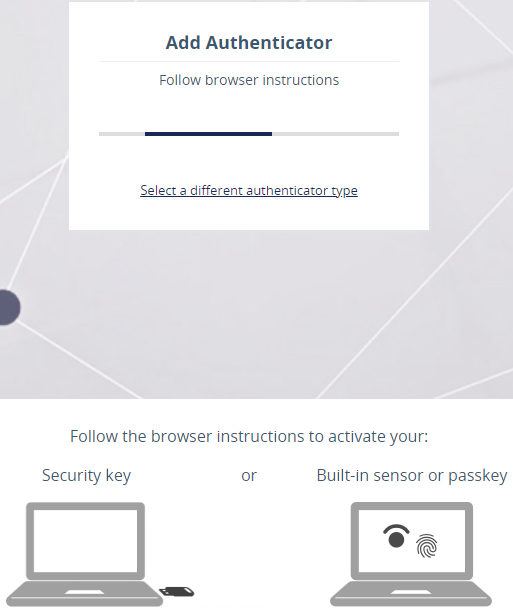
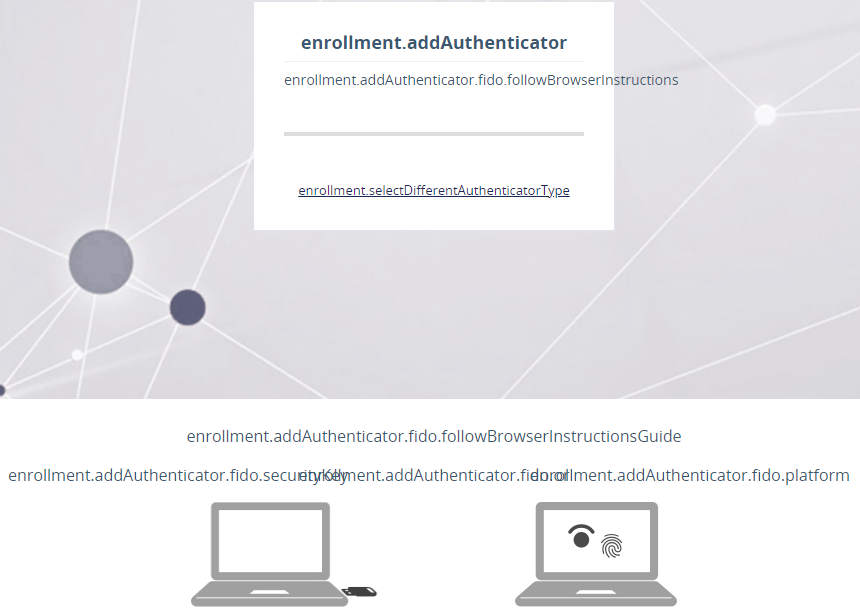
In the language files, you can customize the following values for the FIDO enrollment page:
| Key | Value |
|---|---|
| enrollment.addAuthenticator | Add Authenticator |
| enrollment.addAuthenticator.fido.followBrowserInstructions | Follow browser instructions |
| enrollment.selectDifferentAuthenticatorType | Select a different authenticator type |
| custom.infobox.enrollment | See Custom languages on the user portal and login pages |
| enrollment.addAuthenticator.fido.followBrowserInstructionsGuide | Follow the browser instructions to activate your: |
| enrollment.addAuthenticator.fido.securityKey | Security key |
| enrollment.addAuthenticator.fido.or | or |
| enrollment.addAuthenticator.fido.platform | Built-in sensor or passkey |
FIDO nickname page
The enrollment nickname page appears when a user who already has another token is self-provisioning a FIDO token.
The following images show the location of the key-value pairs on the FIDO nickname page:
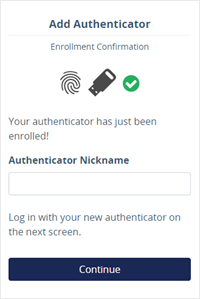
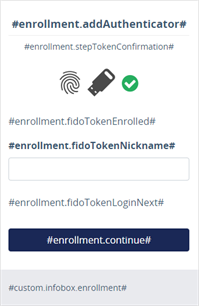
In the language files, you can customized the following values for the FIDO nickname page:
| Key | Value |
|---|---|
| enrollment.addAuthenticator | Add Authenticator |
| enrollment.stepTokenConfirmation | Enrollment Confirmation |
| enrollment.fidoTokenEnrolled | Your authenticator has just been enrolled! |
| enrollment.fidoTokenNickname | Authenticator Nickname |
| enrollment.fidoTokenLoginNext | Log in with your new authenticator on the next screen. |
| enrollment.continue | Continue |
| custom.infobox.enrollment | See Custom languages on the user portal and login pages |
Activate FIDO page
The activate FIDO page appears when the user has an externally managed FIDO token in the pending state, which means that they need to activate it before they can use it to log in.
The following images show the location of the key-value pairs on the activate FIDO page:
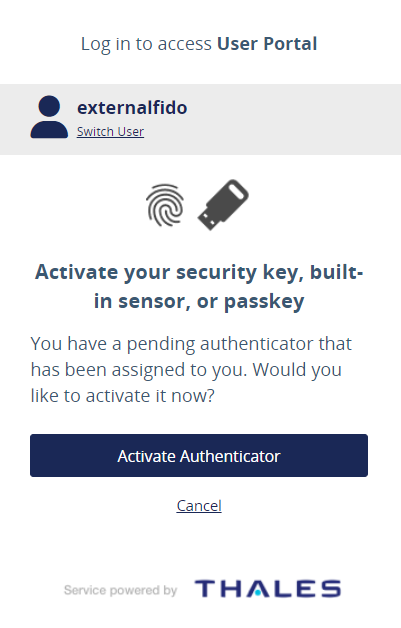
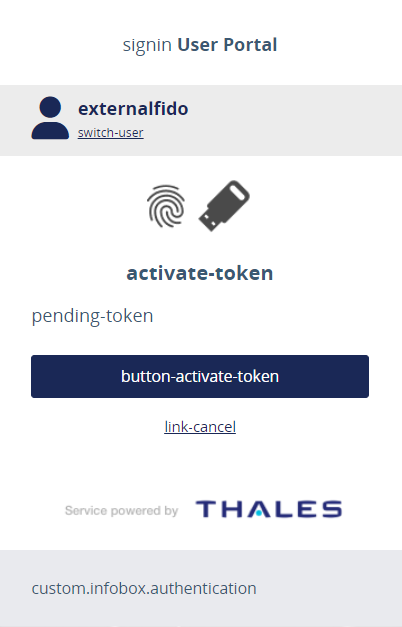
In the language files, you can customize the following values for the activate FIDO page:
| Key | Value |
|---|---|
| signin | Log in to access |
| switch-user | Switch user |
| activate-token | Activate your security key, built-in sensor, or passkey |
| pending-token | You have a pending authenticator that has been assigned to you. Would you like to activate it now? |
| button-activate-token | Activate Authenticator |
| link-cancel | Cancel |
Confirm identity page in the activation flow
The confirm identity page appears during the activation flow, after the user select Activate Authenticator (button-activate-token).
The following images show the location of the key-value pairs on the confirm identity page:
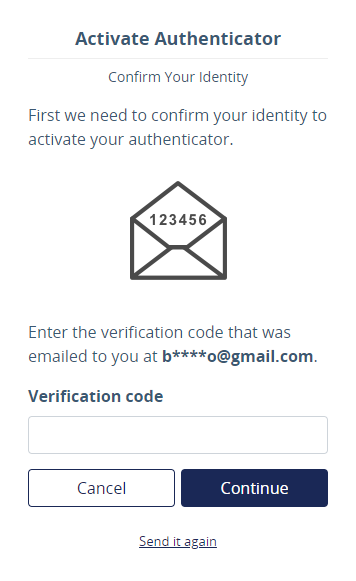
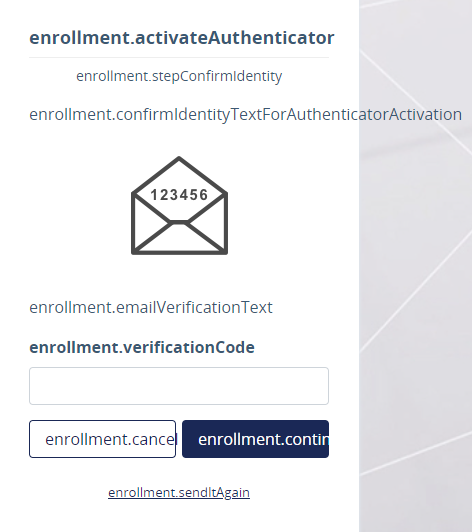
In the language files, you can customize the following values for the confirm identity page in the activation flow:
| Key | Value |
|---|---|
| enrollment.activateAuthenticator | Activate Authenticator |
| enrollment.stepConfirmIdentity | Confirm Your Identity |
| enrollment.confirmIdentityTextForAuthenticatorActivation | First we need to confirm your identity to activate your authenticator. |
| enrollment.emailVerificationText | Enter the verification code that was emailed to you at <strong>{{ maskedEmail }}</strong>. |
| enrollment.verificationCode | Verification code |
| enrollment.cancel | Cancel |
| enrollment.continue | Continue |
| enrollment.sendItAgain | Send it again |
FIDO browser instructions page in the activation flow
The FIDO browser instructions page appears during the activation flow, after the user confirms their identity.
The following images show the location of the key-value pairs on the FIDO browser instructions page:
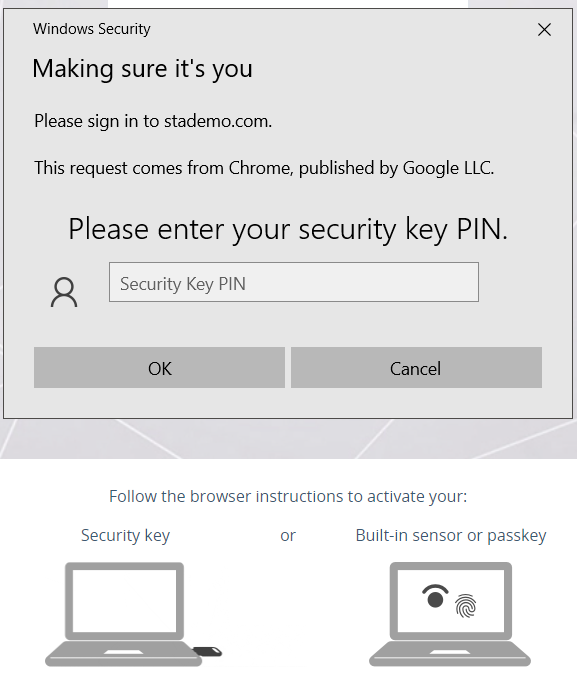
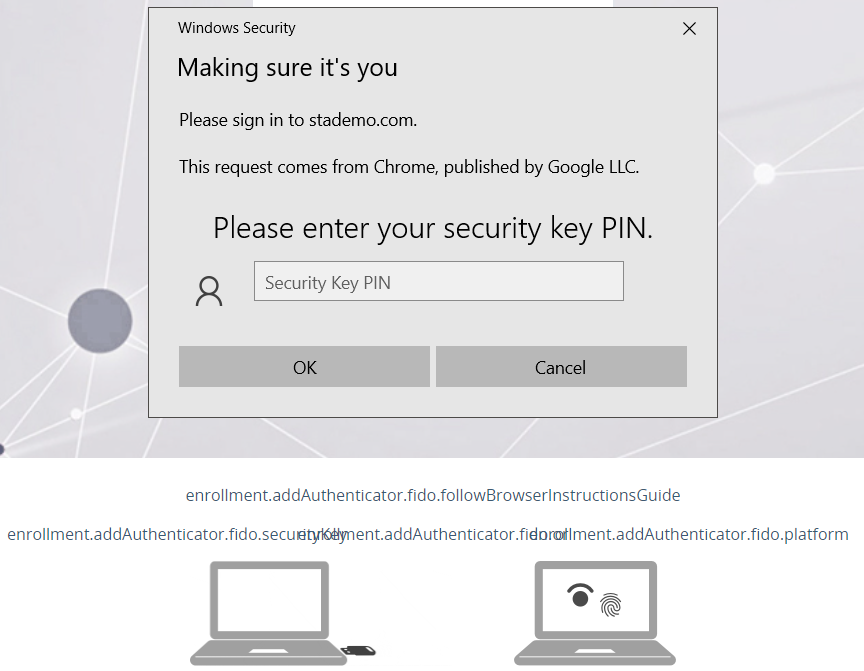
In the language files, you can customize the following values for the FIDO browser instructions page in the activation flow:
| Key | Value |
|---|---|
| enrollment.addAuthenticator.fido.followBrowserInstructionsGuide | Follow the browser instructions to activate your: |
| enrollment.addAuthenticator.fido.securityKey | Security key |
| enrollment.addAuthenticator.fido.or | or |
| enrollment.addAuthenticator.fido.platform | Built-in sensor or passkey |
Authenticator nickname page in the activation flow
The authenticator nickname page appears during the activation flow, after the user follows the browser instructions.
The following images show the location of the key-value pairs on the authenticator nickname page in the activation flow:
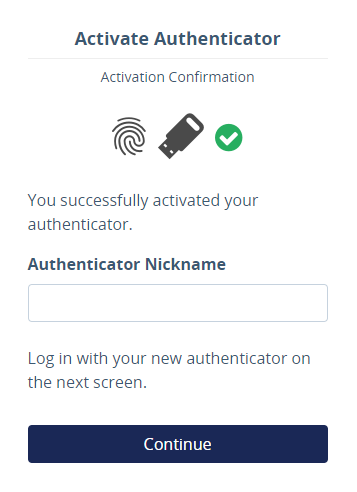
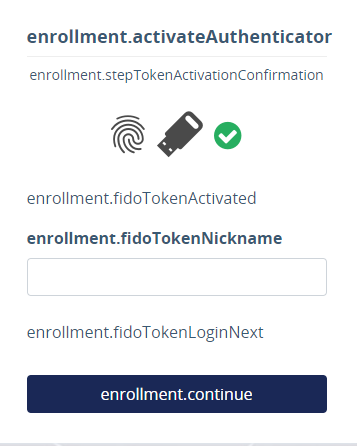
In the language files, you can customize the following values for the authenticator nickname in the activation flow:
| Key | Value |
|---|---|
| enrollment.activateAuthenticator | Activate Authenticator |
| enrollment.stepTokenActivationConfirmation | Activation Confirmation |
| enrollment.fidoTokenActivated | You successfully activated your authenticator. |
| enrollment.fidoTokenNickname | Authenticator Nickname |
| enrollment.fidoTokenLoginNext | Log in with your new authenticator on the next screen. |
| enrollment.continue | Continue |
Messages
Messages include progress, success, and error messages. Error messages can appear in red at the top of the pages or below the field with the error.
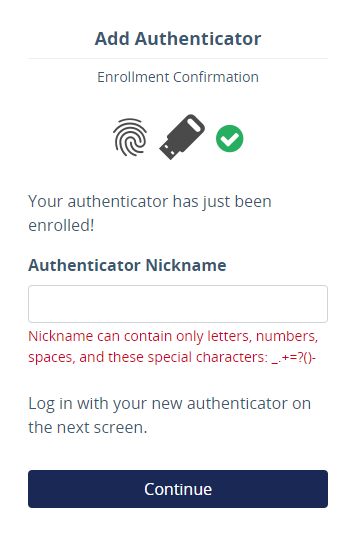
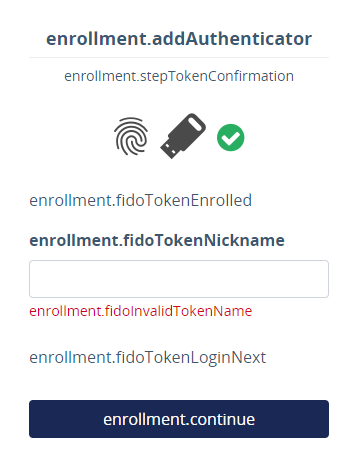
Some error messages can appear on an error page:

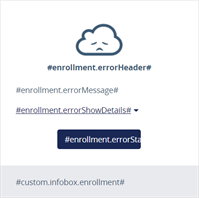
In the language files, you can customize the following messages for the self-provisioning pages:
| Key | Value |
|---|---|
| enrollment.addAuthenticator.browserNotSupported | Your browser doesn't support this type of authenticator. Try again with a different browser. |
| enrollment.addAuthenticator.maxCapacityReached | You have reached the maximum number of authenticators of this type. Ask your administrator to remove an authenticator, so that you can add a new one. |
enrollment.errorHeader |
Oops! |
enrollment.errorMessage |
It's not you, it's us. Please give it another try or contact your administrator if the problem persists. |
enrollment.errorShowDetails |
Show Details |
enrollment.errorHideDetails |
Hide Details |
enrollment.errorStartOver |
Start Over |
enrollment.fidoInvalidTokenName |
Nickname can contain only letters, numbers, spaces, and these special characters: _.+=?()- |
| enrollment.fidoNicknameSaveError | Authenticator Nickname failed to save. Please try again. |
enrollment.installNotWork |
Installation link does not work |
enrollment.invalidCode |
Please provide a valid code. |
| enrollment-succeeded | Success! Now use the authenticator you just activated to log in. |
| enrollment-succeeded-gridsure | Success! You can now use your grid pattern to log in. |
enrollment.unableToAddAuthenticator |
The MobilePASS+ authenticator is not available based on your current device and your administrator's settings.\n\nContact your administrator or help desk for other options. |
enrollment.unableToAddAuthenticator.errorHeader |
Unable to Add Authenticator |

